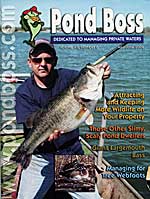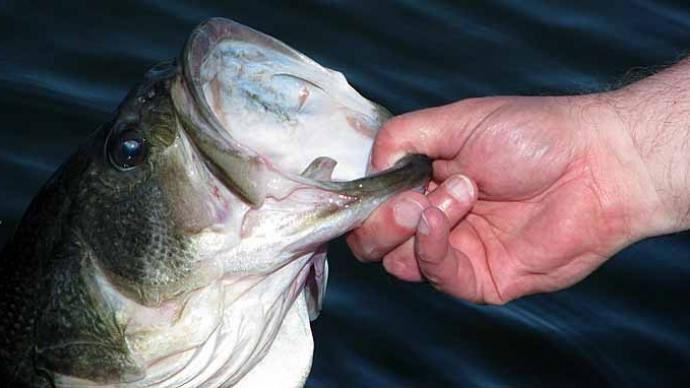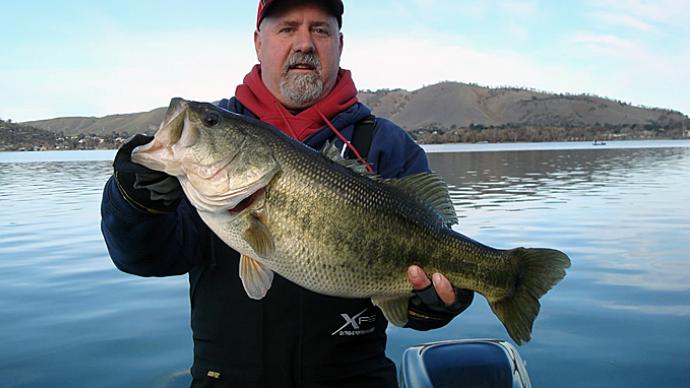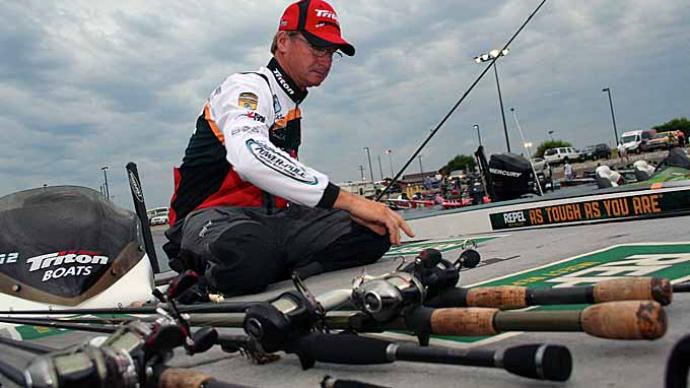
Take a look at the giant bass on this issue's cover. This creature resides in Lake Kiowa, a 570 acre impoundment surrounded by 1400 homes, nestled near the Red River in north Texas. Tipping the scales well beyond 12 pounds, this female Florida strain bass is truly awesome to behold. Or is it?
You've seen pictures in the past. Bass beyond 13 pounds, an ounce or two shy of 14. Dr. Jim Geisler's giant bass in Louisiana. Southeastern Pond Management's client's huge fish on the cover of May/June 2001. Twenty pound bass in California.
Heck, you might have even caught, or seen a double-digit bass in person, live.
When the fish on the magazine cover was gently brought into the electrofishing boat March 30, my heart raced, just like it does EVERY time I get to see a double-digit bass. After a few minutes to weigh, measure, and photograph the beast, it was quickly released. One thrust of its muscled tail, and the egg-laden female headed confidently home.
As I paused, mesmerized by the majesty, entrained in thought about this solitary fish and how it possibly grew so large, one of the guys in the boat trailing the electrofishing boat seemed slightly disappointed, "I was hoping it was a 'sharelunker' size, bigger than 13 pounds."
I love that guy. He's energetic, a hard worker, a key cog in Lake Kiowa's fisheries management wheel.
I wanted to take the fish, and slap his mouth with its tail.
My wife, Debbie, and I attended a banquet April 3, a fundraiser to build a war chest to create classrooms at the world class Texas Freshwater Fisheries Center in Athens, Texas. At the Embassy Suites Hotel, next to Bass Pro Shops in Grapevine, Texas, more than 600 people showed up to mingle with the likes of Johnny Morris, founder of Bass Pro Shops. Dignitaries, professional fishermen, politicians, game wardens and conservationists converged for a good cause.
An amazing thing happened.
One of the live auction items was 1,000 sharelunker bass fingerlings. Each year, the Texas Parks and Wildlife Department collects giant bass caught in Texas waters, then encourages the fish to spawn at the Athens hatchery. Big bass from across the Lone Star state are donated to the program, spawned, then returned to its fisherman/owner, who usually returns the stately fish back to its original environment.
The baby bass come from genetically superior fish, and are perceived by many to have everything a bass needs to grow to giant sizes.
Two guys raised the testosterone in the room when bidding began.
They wanted those fish...real bad.
Bidding started at $5,000. Five bucks apiece for one inch bass? When bids quickly hit $10,000, the entire room gasped. At $15,000, cheers erupted. Less than two minutes later, it was over. Two guys fought, one won. $20,000! $20 each for tiny fish that probably won't make it to adulthood. Twenty grand for 1,000 tiny bass from a giant momma.
What's the deal?
Too many photos, too many stories have a way of evading reality. The reality is this...if you grow a double-digit bass, you are among an elite group of people who's stars lined up at the right time. It's like a 200 point Boone & Crockett whitetail buck. Rare.
That twelve pound-plus bass in Lake Kiowa is the result of more than 10 years effort to manage, stabilize, monitor, tweak and stock an existing, mature fishery. Fish-eating cormorants, too much vegetation, too little vegetation, random catch records, unwitting fishermen harvesting the wrong fish have been overcome for this single solitary bass to grow toward its potential. Can it grow larger? Sure? Will it get the chance? We'll see.
In order for a bass to hit double digits, many factors must come together at the right place, and at the right time. Genetics are crucial. If a fish isn't genetically programmed to grow large, it can't happen. To become giant, a bass must be female. Those odds are 50-50. The food chain must be in order, every day, all year long, for years, with minimal lapses. Lake Kiowa has a diverse food chain including bluegill, redear sunfish, yellow perch, silversides minnows, gizzard shad and threadfin shad. A bass needs the proper cover to keep from being eaten while young, and to hide in ambush during its larger years. Double-digit bass compete from the time they are hatched until they reach five or six pounds. They compete for food, compete for space, compete for cover.
It's a tricky proposition. Even when everything is right, the right food, the right genetics, plenty of cover, appropriate habitat...there's absolutely no guarantee a bass will reach double-digits. No guarantee at all. There is no formula which guarantees a giant bass results from any efforts. Ever.
Biologists over the country strive to contribute to their surrounding environments, trying their best to provide all a fish needs to live well and prosper.
So, if and when you have the honor of seeing a giant largemouth bass, remember this. That large fish is part of a larger mystery, it's genetically superior, has gulped the right size and right amount of food at the right time, and has had the opportunity to defy enormous odds of competition to reach its size.
Huge odds against success make each success a special moment in time.
So the next time you see a picture of a real fish, or get to see, or touch, or hold a real fish that has reached real double-digits, take a breath, and give the fish its due. That, place is a place of honor.
Veteran fisheries biologist Bob Lusk runs Texoma Hatchery pond consulting service. He may be reached at 903-564-5372. His new book, "Raising Trophy Bass," may be purchased by calling 800-687-6075.
Reprinted with permission from Pond Boss Magazine




